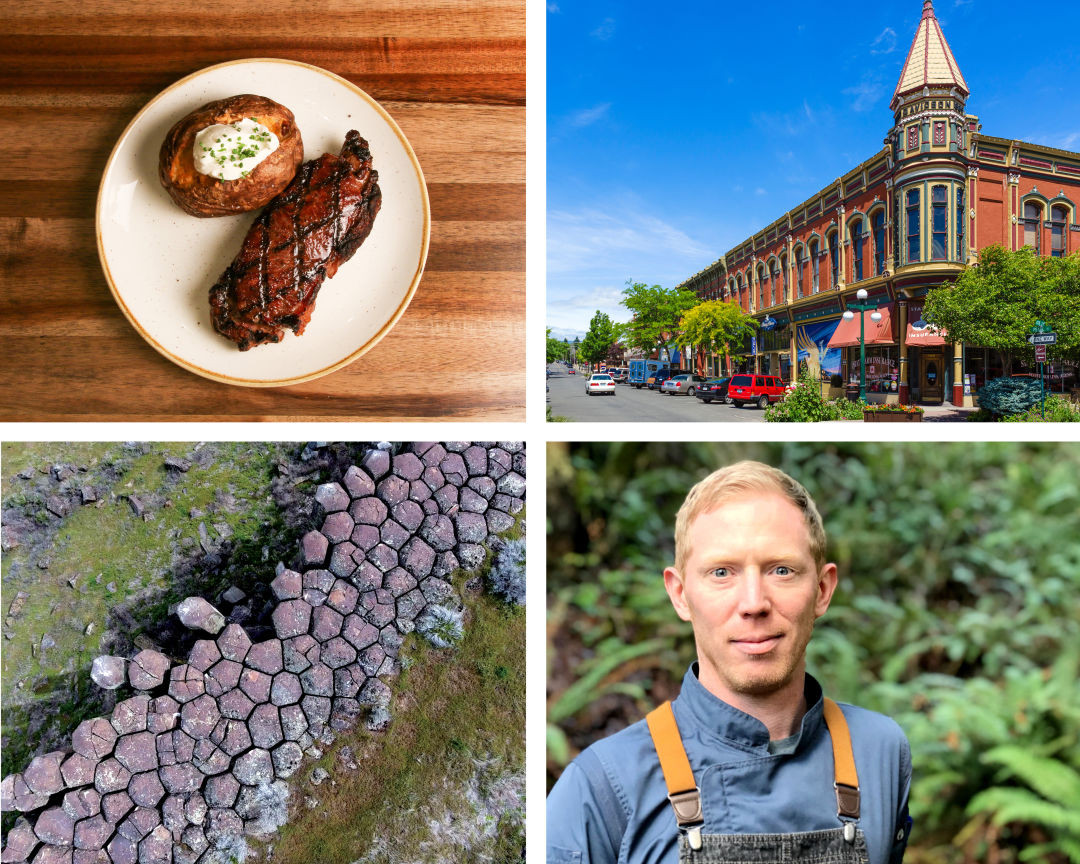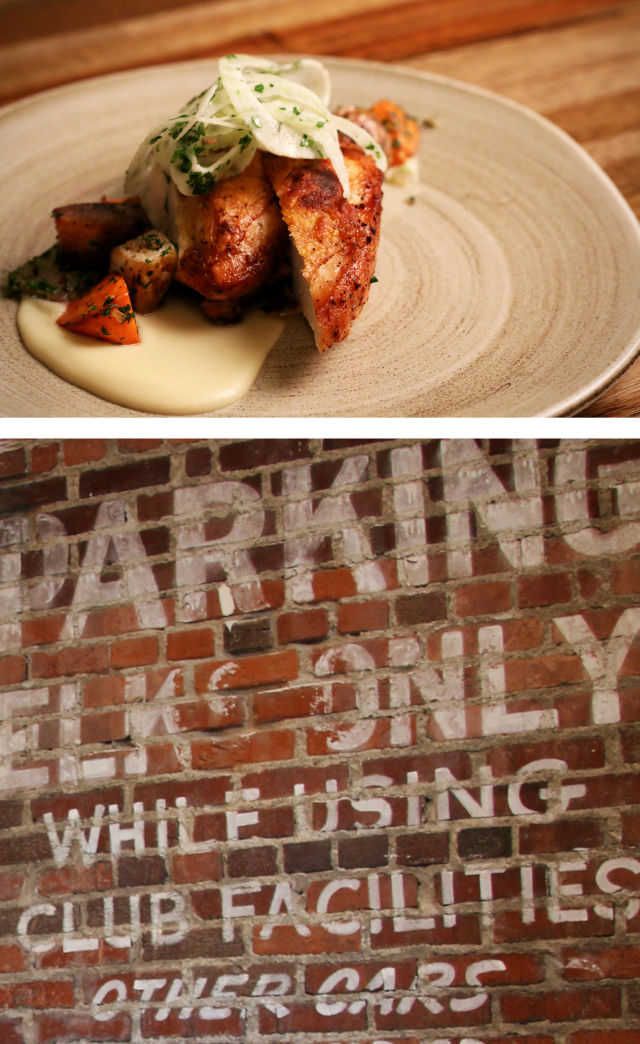Ellensburg is the Center of the Earth (Or Washington, At Least)

Clockwise from left: New York steak at Basalt, historic downtown Ellensburg, chef Larkin Young, and an aerial view of basalt rock.
Oh, whoa. I hope I don’t have to get a job at McDonald’s.” That was chef Larkin Young’s first thought as he exited Interstate 90 to his new town of Ellensburg, already committed to several years in Central Washington while his girlfriend earned a graduate degree. “One of everything under the sun, as far as fast food,” says Young of that freeway exit. After kitchen stints at arguably the two most prestigious restaurants in the state—Seattle’s Canlis and Lummi Island’s Willows Inn—the golden arches would be a rather significant career demotion.
Cut to a year later, as a server delivers a medium rare top sirloin at Young’s brand-new restaurant Basalt on the ground floor of the equally new Hotel Windrow. A practiced speech explains the rich bearnaise, a shiny veal demi-glace, and a trio of salts in a wood block complete with tiny brass salt spoon. One needn’t even consider the creamed rainbow chard to see that Young landed a few dozen steps above Happy Meal.
Open since January, Basalt and the whole 20,000-person city of Ellensburg sit near the geographic middle of Washington. The burg was long known as a refueling stop between Seattle and Spokane, equal parts college and farm town on a flat valley floor that stretches from the Cascades to the Columbia. Change crept across the landscape at a glacial pace, fitting for all the natural science studied here at Central Washington University. But Young’s timing was fortuitous—the Maria Hines–trained chef pulled off I-90 just as investors were erecting a brand-new boutique hotel and restaurant downtown.

Old Elks Lodge signage, Basalt chicken at Hotel Windrow.
Image: Courtesy Hotel Windrow
“I don’t want to intimidate people,” says Young; despite opening the swankiest joint for 50 miles in any direction, he’s not aiming for Canlis: Heartland Edition. Basalt waitstaff wear jeans, albeit dressy ones; diners sport more hoodies than heels. Young may have dished petits fours and foraged greens on the west side of the state, but Basalt is foremost a steak house, offering more than a dozen different cuts from 6-ounce sirloin to 16-ounce rib eye.
Not to say Basalt holds back, given Young’s affinity for “elevating touches.” There’s nothing provincial about the caddy of Himalayan rose, Hawaiian sweet, and French savory salts, or the depth they add to a medium rare bite. A caper beurre blanc accents the salmon; aside the pan-roasted chicken, a sauce soubise.
“There’s less stress and less anxiety here,” not as much pressure to be, as Young says, “perfect perfect perfect every time.” He found the Ellensburg diners patient with launch tweaks, like a failed attempt to dub their demi-glace “B1 Sauce” (customers expected an A.1. flavor). Outside the cutthroat Seattle scene, he says, starting a restaurant is “a little more organic and a little more enjoyable.”
The hotel that opened in tandem with Basalt harbors equally lofty ambitions; the Windrow was constructed next to the town’s old Elks Lodge, turning its exposed brick exterior into the restaurant’s interior wall, painted parking signage intact. Despite a name that references raked hay in a farmer’s field, the hotel is distinctly urban. You’d never confuse these 59 rooms for Ellensburg’s chain motels, not with motion-detected floor lighting and barn-door bathroom entryways.
Basalt will soon launch regular wine dinners, and Windrow’s rooftop deck, the town’s first, opens this month with food and drink service. Sure, the complex will do well during CWU graduations and parents weekends, but the Windrow and Basalt have managed to turn Ellensburg into, no kidding, a stylish weekend retreat, no drive-through menus in sight.

Yakima River Canyon basalt.
“I’m here on purpose,” says CWU academic Nick Zentner. He doesn’t just mean Ellensburg for its cozy small-town vibe, though that too. “Once I found geology, I knew I had to come to a place like this. There’s everything, earthquakes and volcanoes and glaciers and floods and landslides.”
Tall and calm, Zentner speaks with the deliberate cadence of someone who’s taught a lot of overwhelmed freshmen. He lectures not only in the classroom but, since 2010, for the public in a downtown series every April. Even a decade in, he still sounds surprised at how crowds, people with no midterm or STEM gig on the horizon, fill a 700-seat Ellensburg auditorium. “I use a chalkboard for 30 minutes. It’s about as old-school as it gets,” he says.
The format works, maybe because all that chalk dust and pedagogy elicits fuzzy nostalgia—or maybe because Zentner is so good at turning the interminably slow churn of geologic time into a snappy tale. He’s even made bite-size versions of rock talk into a video series for KCTS. This year’s lectures are, as always, novel topics, one night branching into the links between Native American culture and the geologic record. [Update 4/6/20: While Zentner's 2020 in-person lectures were canceled for the COVID-19 quarantine, he's doing daily videos from his backyard during March and April.]
For Zentner, the story of Central Washington is anything but sleepy; it twists with ice age floods that shaped the boxy coulees to the east. It blows the mind with the 93-million-year-old granite that forms Mount Stuart just to the north, and beguiles with the fact that no one has totally figured out quite why the region’s legendary basalt columns look as they do.
“We’re in the middle of it all here in Ellensburg,” he says. Increasingly, he’s not the only one that sees it.




